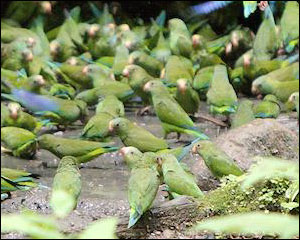Pratique | Débuter
La géophagie chez les perroquets

Touis de Deville (Brotogeris cyanoptera) sur un site de géophagie à proximité du Napo Wildlife Center, Équateur, juin 2010.Photographie : Bruno Tredez
Introduction
La géophagie est l’ingestion de substances minérales, dont l’argile. Elle est très répandue dans le monde animal, mais aussi chez l’Homme (dans les communautés primitives ou défavorisées, et dans plusieurs anciennes civilisations). De nombreuses espèces d’oiseaux sont géophages de façon régulière ou occasionnelle. La géophagie est particulièrement fréquente chez les Psittacidés : les groupes d’aras se nourrissant sur certaines berges argileuses des rivières d’Amazonie font ainsi partie des plus beaux spectacles de la nature.
Bruno Tredez (site web : bruno.tredez.com) a assisté en juin 2010 à des rassemblements de centaines de Touis de Deville et de Conures de Weddell près du Napo Wildlife Center en Équateur.
Nous vous proposons une présentation des fonctions de la géophagie et des facteurs pouvant l’influencer.
Abstract
Geophagy is the practice of eating earthy or soil-like substances such as clay, and chalk, in order to obtain essential nutrients such as sulfur and phosphorus from the soil. This practice is widespread among animals in the wild, as well as in human societies. Geophagy is widespread among animals, and it has has been documented in many species of mammals, birds, reptiles, butterflies and isopods, especially among herbivores. It is well documented in birds, notably in many species of parrots. Hypotheses proposed to explain the function of geophagy include soil as an aid to digestion, as a buffer against acids, as a mineral supplement, as an aid in the adsorption of dietary toxins, and in gastrointestinal cytoprotection. There are links between the clay lick, the nesting period, the tree phenology (flowering and fruiting) and the movements of parrots.
Lots of parrots species from all over the world eat soil from clay licks, salt licks or other sites. Bruno Tredez watched hundreds of Dusky-headed Parakeets and Cobalt-winged Parakeets in September 2010 near the Napo Wildlife Center, Ecuador. He sent us fantastic photos.
Poursuivez la lecture de cet article, en vous abonnant dès maintenant !
Découvrez les Archives d’Ornithomedia.com
Pour seulement 10,00 €TTC/an (ou 6,00 € les 6 mois)
Profitez de plusieurs centaines d’articles en accès illimité et sans aucun engagement.
Compléments
À lire aussi sur Ornithomedia.com
À lire sur le web
- Le site web de Bruno Tredez : bruno.tredez.com
- La galerie de photos de Pendens Proditor : www.flickr.com/photos/pendensproditor
Ouvrages recommandés
- Perroquets du monde Domenico Mario et al
- Parrots of the World Joseph M. Forshaw et Frank Knight
- Birds of Peru Douglas F. Stotz, Thomas S. Schulenberg, John P. O’Neill et Theodore A. Parker
- A Field Guide to the Birds of Peru James F. Clements
Sources
- G. Werguin (2007) Argile et santé. Ornitho info. Numéro 32. http://www.versele-laga.com/Nutri/Nutrition/Library/Versele-Laga/PDF/Ornitho/Info32fr.pdf
- Charles A. Munn, Ph.D . Macaw clay licks. Inkanatura. http://www.inkanatura.com/macawclaylicks.asp
- Donald Brightsmith (2003). The real dirt on parrot clay licks. http://vtpb-www2.cvm.tamu.edu/brightsmith/Real%20dirt%20on%20clay%20licks.htm
- Rainforest Expeditions. Macaw Clay Lick Tambopata Candamo. Go2Peru. http://www.go2peru.com/macaw_clay_lick.htm
- Rene A. Valdés-Peña, Sonia Gabriela Ortiz-Maciel, Simon O. Valdez Juarez, Ernesto C. Enkerlin Hoeflich, et Noel F. R. Snyder (2008). Use of Clay Licks by Maroon-Fronted Parrots (Rhynchopsitta terrisi) in Northern Mexico. The Wilson Journal of Ornithology 120(1). Pages 176-180. http://www.bioone.org/doi/abs/10.1676/06-128.1
- James D. Gilardi, Sean S. Duffey, Charles A. Munn et Lisa A. Tell. Biochemical Functions of Geophagy in Parrots: Detoxification of Dietary Toxins and Cytoprotective Effects. Journal of chemical ecology. Volume 25, Numéro 4, pages 897-922. http://www.springerlink.com/content/m52r1535p1j63750/
- Powell, L. L., Powell, G. V., Powell, T. U. et Brightsmith, D. (2008). PARROTS TAKE IT WITH A GRAIN OF SALT: 18 SOIL LICKS IN SOUTHEAST PERU ARE HIGH IN AVAILABLE SODIUM. Article présenté lors de l’annual meeting of the International Congress for Conservation Biology, Convention Center, Chattanooga. http://www.allacademic.com/meta/p243978_index.html
- Donald Brightsmith (2004). Effects of Diet, Migration, and Breeding on Clay Lick Use by Parrots in Southeastern Peru. Rédigé pour l’American Federation of Aviculture 2004
- Symposium Proceedings Introduction. vtpb-www2.cvm.tamu.edu/…/Clay%20lick%20seasonality%20AFA.pdf
- C. T. Symes, J. C. Hughes, A. L. Mack & S. J. Marsden (2006). Geophagy in birds of Crater Mountain Wildlife Management Area, Papua New Guinea. Journal of Zoology. Volume 268, volume 1, pages 87–96. http://onlinelibrary.wiley.com/doi/10.1111/j.1469-7998.2005.00002.x/abstract





Aucun commentaire sur ce sujet
Participer à la discussion !